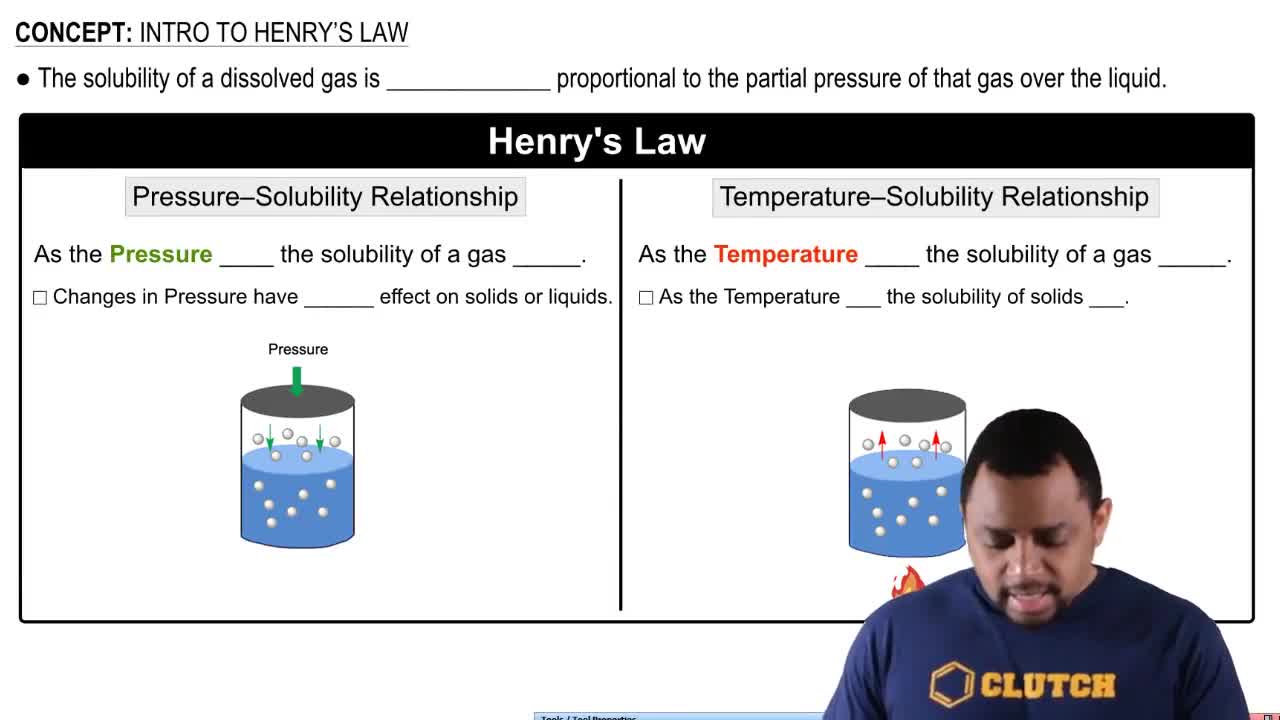In each pair of compounds, pick the one with the higher vapor pressure at a given temperature. Explain your reasoning. a. CH4 or CH3Cl c. CH3OH or H2CO
Ch.11 - Liquids, Solids & Intermolecular Forces
Chapter 11, Problem 45a,b,c
Determine whether each pair of compounds forms a homogeneous solution when combined. For those that form homogeneous solutions, indicate the type of forces that are involved. a. CCl4 and H2O b. KCl and H2O c. Br2 and CCl4
 Verified step by step guidance
Verified step by step guidance1
Identify the polarity of each compound: CCl4 (carbon tetrachloride) is a nonpolar molecule because the individual bond dipoles cancel each other out. H2O (water) is a polar molecule due to its bent molecular shape and the difference in electronegativity between hydrogen and oxygen.
Assess the solubility based on polarity: Nonpolar substances tend to dissolve well in nonpolar solvents, and polar substances tend to dissolve well in polar solvents. Since CCl4 is nonpolar and H2O is polar, they are likely not to form a homogeneous solution.
Consider the 'like dissolves like' principle: This principle states that substances with similar intermolecular forces are likely to be soluble in each other. CCl4 and H2O have different types of dominant intermolecular forces.
Identify the dominant intermolecular forces in each compound: CCl4 primarily exhibits London dispersion forces, while H2O exhibits hydrogen bonding, which is much stronger.
Conclude whether a homogeneous solution will form: Based on the differences in polarity and intermolecular forces, CCl4 and H2O are unlikely to form a homogeneous solution when combined.

Verified video answer for a similar problem:
This video solution was recommended by our tutors as helpful for the problem above.
Video duration:
2mWas this helpful?
Key Concepts
Here are the essential concepts you must grasp in order to answer the question correctly.
Polarity
Polarity refers to the distribution of electrical charge over the atoms in a molecule. Polar molecules, like water (H2O), have a significant difference in electronegativity between their atoms, leading to a partial positive charge on one side and a partial negative charge on the other. In contrast, nonpolar molecules, such as carbon tetrachloride (CCl4), have an even distribution of charge. Understanding polarity is crucial for predicting solubility and the formation of homogeneous solutions.
Recommended video:
Guided course

Molecular Polarity
Intermolecular Forces
Intermolecular forces are the forces of attraction or repulsion between neighboring particles (atoms, molecules, or ions). These forces include hydrogen bonding, dipole-dipole interactions, and London dispersion forces. The type and strength of these forces determine whether two substances will mix homogeneously. For example, polar substances tend to mix well due to dipole-dipole interactions, while nonpolar substances mix due to London dispersion forces.
Recommended video:
Guided course

Intermolecular vs Intramolecular Forces
Like Dissolves Like
The principle of 'like dissolves like' states that polar solvents tend to dissolve polar solutes, while nonpolar solvents dissolve nonpolar solutes. This concept is essential for predicting whether two compounds will form a homogeneous solution. In the case of CCl4 and H2O, the polar nature of water and the nonpolar nature of carbon tetrachloride means they will not form a homogeneous solution, as their intermolecular forces do not favor mixing.
Recommended video:
Guided course

Henry's Law Solubility
Related Practice
Textbook Question
Textbook Question
In each pair of compounds, pick the one with the higher vapor pressure at a given temperature. Explain your reasoning. b. CH3CH2CH2OH or CH3OH
Textbook Question
Determine whether each pair of compounds forms a homogeneous solution when combined. For those that form homogeneous solutions, indicate the type of forces that are involved. d. CH3CH2OH and H2O
Textbook Question
Determine whether each pair of compounds forms a homogeneous solution when combined. For those that form homogeneous solutions, indicate the type of forces that are involved. a. CH3CH2CH2CH2CH3 and CH3CH2CH2CH2CH2CH3 b. CBr4 and H2O c. LiNO3 and H2O d. CH3OH and CH3CH2CH2CH2CH3
Textbook Question
Which compound would you expect to have greater surface tension: acetone [(CH3)2CO] or water (H2O)? Explain.
